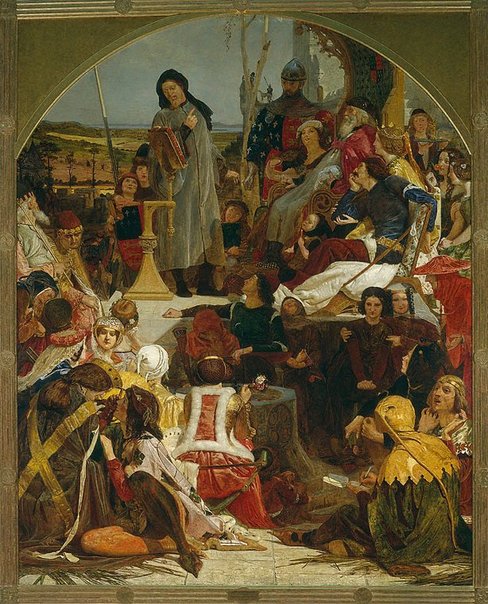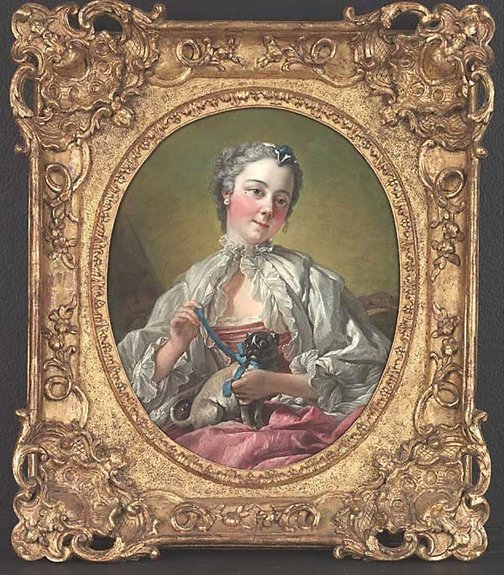TASK: Write a short summary of your gallery visit today. Mention 2 or 3 of the paintings that most appealed to you and why.
My visit to the NSW Art Gallery this week was one of great interest and also reluctance. Reluctance because I was wondering why we were going to look at art, when we were literature students? While at the gallery, the answer hit me like a bolt of lightning. The answer was because, like languages, most aspects between subjects, like art and English, can be translated and recognised in each other. Once I had this realisation, I had an innate desire and curiosity to study these paintings further and see what I could find for myself. Two, in particular, struck me.
“Chaucer at the Court of Edward III” by Ford Madox Brown (1847) was one painting that struck me. I thought this was a lovely painting, not just because of the bright and vibrant colours, but because of the celebration of the English language. The painting depicts a variety of people at court, who are all engaged in conversation of some kind with each other. Everyone seems to have something to say and they seem to have an interest in what’s going on; they are all paying attention to each other and giving them their undivided attention – something rare nowadays, what with the various distractions technology provides.

“Chaucer at the Court of Edward III” (1847). Image from: https://www.artgallery.nsw.gov.au/collection/works/703/
The other that struck a chord with me was “A Young Lady Holding a Pug Dog” by Francis Boucher (c. 1740s). This is a painting from the Enlightenment period and it makes clear to me why people wanted a Revolution and wanted change in society. The girl in the painting is portrayed in an uptight, uncomfortable position with a rigid back and wearing extravagant, pretentious clothes. This makes the painting seem forced and a lot less natural, unlike paintings of the Romantic era, where people seemed to be captured in the moment, like “Chaucer at the Court of Edward III”. The pug the girl is holding has a ribbon around its neck – perhaps representing the oppression the lower classes were placed under by the upper class and how the upper class thought themselves so superior because of their refined and restrained manners. It represents the hold the aristocracy held on everyone, even animals like the dog. The rigidity and tyranny of the upper class, represented in this painting, makes it obvious to me why people were keen for a Revolution at the time and, while the methods and what happened during the Revolution is a sad thought, it makes me feel better about the 21st century world that we don’t have those kind of social barriers.

“A Young Lady Holding a Pug Dog” (1740s). Image from: https://www.artgallery.nsw.gov.au/collection/works/118.1992/
LINK to tutor’s praise on this blog post (scroll down for comment): https://michaelgriffith1.com/2017/06/09/best-nineteenth-century-literature-eportfolio-blogs/
Hey Felicity congrats on getting this done on time! Your intro was effective in conveying your initial and later feelings on the Art Gallery visit in week 7, as well as making the connection between analysing literary works and interpreting artworks. I found it particularly relatable and much more straightforward that you used personal language as opposed to writing in a much more analytical third-person manner. I think your choice of paintings from the Romantic and Enlightenment eras are appropriate. Although I do think you described the vibrancy and excitement of the Chaucer painting quite well, I tend to think that the people in it are for the most part not paying attention to the poetry being spoken above, which in my opinion isn’t that different from Modern times. Your analysis of the Boucher’s painting is quite accurate as well as the general societal sentiment you can extrapolate from it, though I disagreed with your interpretation of tying the red ribbon around the dog to represent a stranglehold on society. I instead thought based on the description at the Art gallery that it was her ensnaring her lover as a sign of indulgence.Regardless it’s an interesting viewpoint that was thought provoking and fits in with the themes.
LikeLike
Felicity! Lovely blog. I also chose to speak about “Chaucer at the Court of Edward III” by Ford Madox Brown (1847) because it also spoke to me. What I feel that I didn’t achieve in my blog post is explain how I felt that the people depicted in the painting reacted to the story (?) that was being told. I do not believe that they were all engaged, rather, I felt that there were mixed emotions. Its vibrant colouring was almost divine like, which I see you’ve spoken of. I agree! Wonderful blog! Keep up the amazing work!
LikeLike
Hey Felicity!
I enjoyed reading your blog this week. I admire the courage it takes to be reluctant towards something but still be open-minded about the experience for all it has to offer. Your thought process of, “The answer was because, like languages, most aspects between subjects, like art and English, can be translated and recognised in each other.” was eloquently articulated, and impacted me, as this is a familiar sensation from a past experience.
You then took this a step further in the analysis of your first choice of artwork. Relating your perception of the conversations and tying it back into your sudden-found realisation that art communicates languages. This was an insightful blog post. See you in class!
LikeLike
Fabulous Felicity, you have shared such an important moment in the growth of your understanding! Well done. And well written!
LikeLike